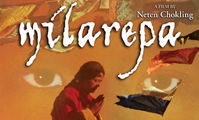MILAREPA: MAGICIAN, MURDERER, SAINT
Unlike many Hollywood movies sensationalizing revenge, Milarepa shows its destructiveness and futility.
Published Oct 2, 2007
[an error occurred while processing this directive]
Edit page New page Hide edit links
The feature takes us through the formative years of Tibetan's greatest mystic of the eleventh century, Thöpaga, later named Milarepa, and his road to enlightenment.
Thöpaga was the only son of a wealthy merchant family. After falling severely ill, Thöpaga's father entrusted the family's estate to his brother Gyaltsen (Gonpo) who was to return it to Thöpaga when Thöpaga marries.
Rather than honoring his brother's death wish, the greedy Gyaltsen enslaved into hard labor, Thöpaga (Jamyang Lodro, at age 16), his mother Kargyen (Kelsang Chukie Tethong), and his sister Peta (Tashi Lhamo, at age 13). When Thöpaga reached the age to marry, uncle Gyaltsen claimed the family's fortune as his own.
Kargyen received no support from the villagers. Humiliated, she seeks to avenge the injustices suffered. She sends Thöpaga to learn black magic with master sorcerer Yongten Trogyal (Orgyen Tobgyal) and bring destruction upon Gyaltsen and his village followers.
Though revenge is achieved, Thöpaga comes to realize that it is an empty victory, and pursues the path of spirituality to find inner peace.
The feaure's cast and crew consisted mostly of Buddhist monks, of which over 50 came from the Pema Ewam Chogar Gyurme Ling Monastery in Northern India. Props and costumes, borrowed from local homes and monasteries, provided the film an authentic eleventh century flavor.
Debuting writer and director Tibetan lama, Neten Chokling, relays that shooting in the Indian Himalayas, at high altitude and cold weather, presented a serious challenge and required real team work. Production decisions such as shooting dates, locations, film stocks, and cast and crew, were all based on a series of Tibetan divinations. A team of monks and lamas were assembled to perform numerous sacred rituals to pacify the negativity encountered when shooting.
Noteworthy in this feature is Paul Warren's magnificent cinematography capturing in long shots the breathtaking Spiti Valley, on the Indo-Tibetan border.
Lyrics from "The Hundred Thousand Songs of Milarepa" were sung by highly acclaimed Kelsang Chukie Tethong, also in the role of Thöpaga's mother, Kargyen, as well as by Tibetan nun Ani Choying Drölma.
Aside from being a filmmaker, Chokling heads two monasteries, one in Tibet housing 100 monks, and the other in the Indian Himalayan foothills with 150 monks, and an orphanage of 40.
The present features' focus on Milarepa's formative years was selected "to emphasize the importance of starting a spiritual path based on one's own raw experience of suffering" and "what makes you sincere is how grounded you are in the truths of life" explains director Chokling.
The movie's ending leads to the upcoming sequel to be released in 2009, on the later life of Milarepa.
[In Technology]
Additional Events at ProFusion 2011, DV Expo East, and Columbia College Chicago May 26, 2011
[In Resources]
Fest to fete special guests Vera Farmiga, Paul Haggis; Mike O’Malley joins Anne Meara as hosts of Late Night Storytelling May 26, 2011




Add a Comment
Please be civil.